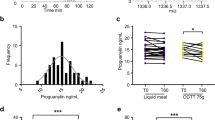Abstract.
Five types of zymogens of pepsins, gastric digestive proteinases, are known: pepsinogens A, B, and F, progastricsin, and prochymosin. The amino acid and/or nucleotide sequences of more than 50 pepsinogens other than pepsinogen B have been determined to date. Phylogenetic analyses based on these sequences indicate that progastricsin diverged first followed by prochymosin, and that pepsinogens A and F are most closely related. Tertiary structures, clarified by X-ray crystallography, are commonly bilobal with a large active-site cleft between the lobes. Two aspartates in the center of the cleft, Asp32 and Asp215, function as catalytic residues, and thus pepsinogens are classified as aspartic proteinases. Conversion of pepsinogens to pepsins proceeds autocatalytically at acidic pH by two different pathways, a one-step pathway to release the intact activation segment directly, and a stepwise pathway through a pseudopepsin(s). The active-site cleft is large enough to accommodate at least seven residues of a substrate, thus forming S4 through S3′ subsites. Hydrophobic and aromatic amino acids are preferred at the P1 and P1′ positions. Interactions at additional subsites are important in some cases, for example with cleavage of κ-casein by chymosin. Two potent naturally occurring inhibitors are known: pepstatin, a pentapeptide from Streptomyces, and a unique proteinous inhibitor from Ascaris. Pepsinogen genes comprise nine exons and may be multiple, especially for pepsinogen A. The latter and progastricsin predominate in adult animals, while pepsinogen F and prochymosin are the main forms in the fetus/infant. The switching of gene expression from fetal/infant to adult-type pepsinogens during postnatal development is noteworthy, being regulated by several factors, including steroid hormones.
Similar content being viewed by others
Author information
Authors and Affiliations
Additional information
Received 25 May 2001; received after revision 27 August 2001; accepted 30 August 2001
Rights and permissions
About this article
Cite this article
Kageyama, T. Pepsinogens, progastricsins, and prochymosins: structure, function, evolution, and development. CMLS, Cell. Mol. Life Sci. 59, 288–306 (2002). https://doi.org/10.1007/s00018-002-8423-9
Published:
Issue Date:
DOI: https://doi.org/10.1007/s00018-002-8423-9




